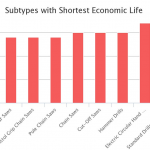This graph shows the average expected economic life of the top 5 equipment types.
Key Takeaways for Decision Makers
CONTRACTOR: Pay attention to the average number of years equipment is expected to last before reaching its economic life. A similar type of equipment function with a longer life might be a better fit.
When analyzing data that supports MagikMe Equipment’s Rental Rate Blue Book and Custom Cost Evaluator, we can determine the time in years we expect a type of equipment to last before it reaches the end of its economic life. The equipment type and its function play a role in its expected economic life as well as annual use hours.
Out of 460 types of equipment analyzed, vertical earth drills for crane mounting have the longest economic life at 23.1 years on average. The high economic life hours (15,000 on average) and low annual use hours (650 on average) puts this equipment type at the top of the list.
Following very closely in second place, deck cargo barges have an average economic life of 22.3 years. This equipment type has the highest average economic life hours of 39,000, and is only used 1,750 hours per year on average creating a very long economic life.
Next on the list are hydraulic locomotive cranes. With economic life hours averaging around 26,000 and an average annual use of 1,200 hours, you can expect this type of crane to last 21.7 years before reaching the end of its economic life.
Hydraulic cutter suction dredges can be expected to last 20.8 years on average before reaching the end of its economic life. While it may have the second highest average economic life hours (34,375) of all 460 equipment types, it also has one of the highest average annual use hours (1,658) which causes this subtype to fall in the fourth spot.
Last but not least are 3-wheel compactors. On average this equipment will have an economic life of 20.6 years which is based on 11,000 economic life hours and 535 annual use hours on average.


